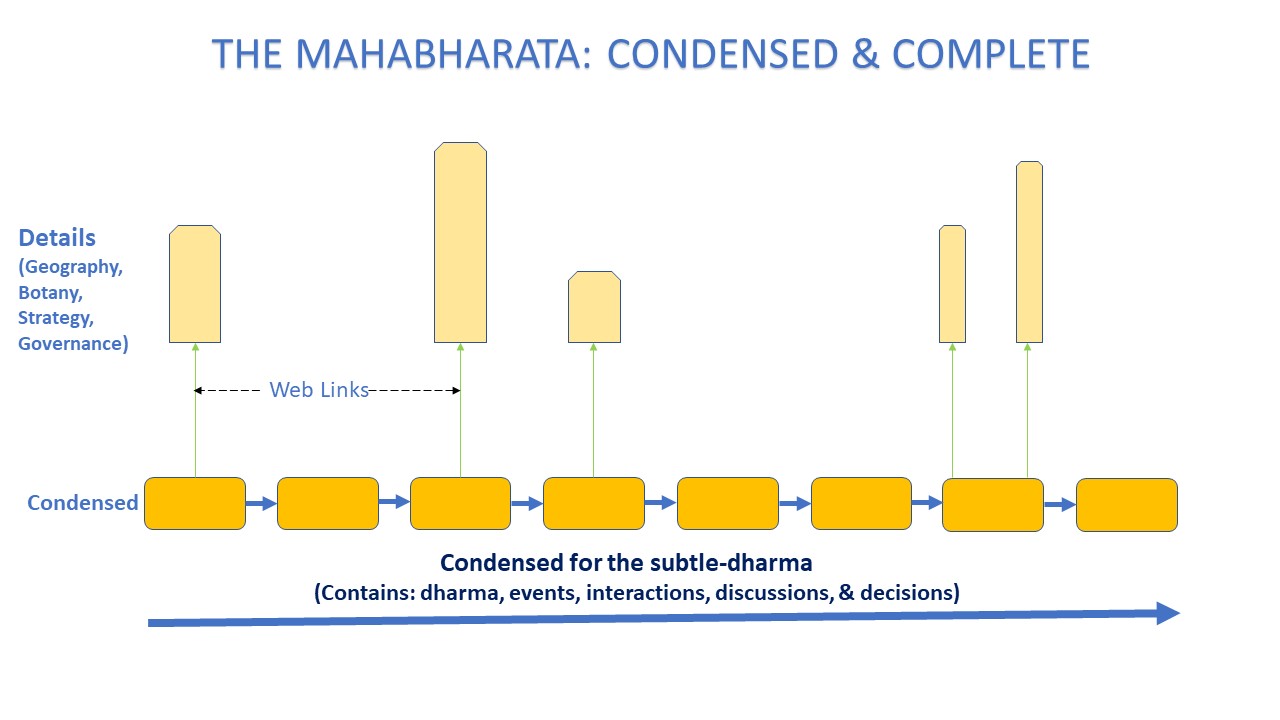Introduction
As a child, my favourite book was the Indrajal Comics version of The Mahabharata. I still remember the cover of Sri Krishna showing his viraat swaroop to Arjuna on the battlefield. I was so mesmerized by that image that I’d sit and look at it for hours. I must have read this book more than a dozen times in my childhood.

Much later, when I was in college, I read a 700-plus page translation of the epic, and then, recently, I read another abridged version.
However, one day, quite by chance, I watched a video discussion about the Mahabharata on Youtube. Intrigued by the discussion, I went on to watch a few more videos. That’s when I realized that I had missed the most important parts of the epic by reading the abridged versions. The summarized versions of the Mahabharata contained just the story, however, they did not give me any insights about the subtle thread of dharma that runs right from the beginning to the end of the epic.
The Mahabharata is a lot more than simply a story of the rivalry between the Kauravas and Pandavas, the mention of Gods and Goddesses, and the admonishment given by Sri Krishna to Arjuna on the battlefield. First and foremost, it is a story about subtle dharma. We see the subtle dharma in situations and characters that are not clearly good or bad. However, despite being in the gray area, there emerges in the situation a clear course of action that aligns with the truth. This clear action can roughly be called the “truth of the moment”. That is the subtle dharma that Sri Krishna tells us can be understood by the cultivation of yogastha buddhi.
Besides this, the Mahabharata is also called the fifth Veda because it combines knowledge of all four Vedas and many Upanishads. Rishi Ved Vyasa, the composer of the epic said that the Mahabharata contains every possible human story.
The parts of the epic where the subtle dharma comes out in its full glory are the specific discussions in dharma, interactions between characters, decisions, and the reasons for making those decisions.
All these points that make the epic worthy of reading for the student of dharma are lost in the summarized translations because they focus primarily on the events and a few discussions and decisions.
One option, then, is to read the entire unabridged epic to obtain its full benefit. But there are several challenges on this path. The unabridged version of the Mahabharata is huge. Kisari Mohan Ganguli’s translation is over 7500 pages and Bibek Debroy’s translation, based on the BORI version, is about the same length.
The good news is that a reader who wants to focus mainly on the subtle dharma does not need to read the entire epic. It’s because the Complete Mahabharata contains extensive description of the geography along with the flora and fauna of that time. It also contains large discourses on statesmanship and governance. It contains several long lists of names (eg: names of all the 100 Kaurava brothers, etc). Finally, discussions are very repetitive in nature.
I’m publishing this web book as a two-tiered book for an audience of readers who are interested in the subtle dharma. Let me explain…
Tier-I will be the summarised version of The Mahabharata. It will contain all the events, passages on the dharma, discussions, conversations, decisions made by various characters, as well as the reasons for those decisions.
Tier-II will contain other details such as geography, flora, fauna, statesmanship, and governance.
Excessive repetition from both tiers will be rephrased in a concise and clear way.
The image at the top explains this concept in a visual manner.
Besides being a two-tiered narrative, this version has several other features:
- Every page has a comment section, where readers can ask questions
- Wherever possible, I will embed videos and link to external resources for details or nuances about the topic covered in the page
- Difficult-to-comprehend relationships will be presented visually instead of an incomprehensible wall-of-text
- Many posts will contain journaling entries that will help you explore your own life, swadharma, and swabhāva.
Dedication
Dear reader, I hope you enjoy perusing this translation and you glean from it the subtle dharma that Rishi Ved Vyasa had intended for his readers to imbibe.
I dedicate my translation to the Goddess Adi Para Shakti who incarnated as Draupadi to facilitate the transition from Dwapara Yuga to Kali Yuga.
OM SRI MHATRE NAMAH


